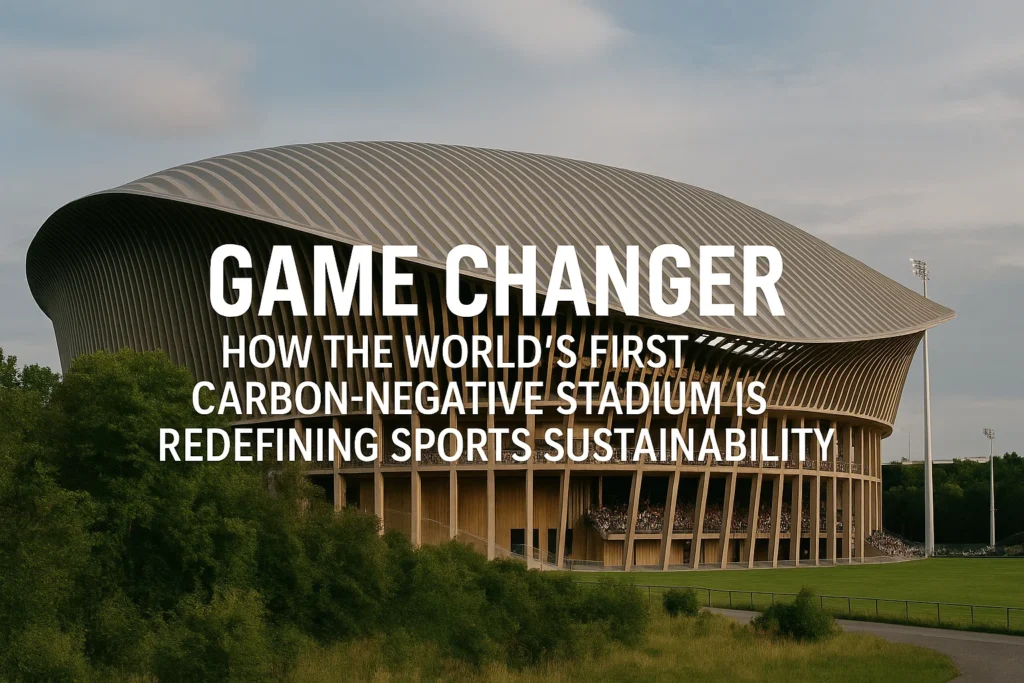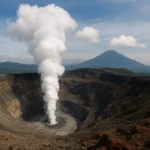A Revolution in Concrete and Steel
When the first spectators passed through the turnstiles of Parken 2.0 on that crisp September evening in 2025, they weren’t just entering a football stadium – they were stepping into the future of sustainable architecture. The air carried an unexpected freshness, the structure seemed to breathe with the crowd, and the very materials comprising the stands had once been part of Copenhagen’s urban fabric. This wasn’t merely a new home for FC Copenhagen – it was a bold statement about humanity’s ability to reconcile massive infrastructure projects with environmental responsibility.
The stadium’s opening match marked the culmination of seven years of radical innovation in materials science, energy systems, and ecological design. While traditional stadiums rank among the most resource-intensive structures humans build – consuming tens of thousands of tons of concrete and steel while guzzling enough electricity to power small towns – Parken 2.0 had flipped this paradigm on its head. Through a combination of cutting-edge biotechnology, circular material sourcing, and energy-positive systems, the stadium would actually remove more carbon dioxide from the atmosphere than it emitted over its lifetime.
Breaking Ground: The Philosophy Behind the Project
From Carbon Neutral to Carbon Negative
The design team, led by visionary architect Lars Jensen, began with a radical question: “What if a stadium could be more like a forest than a building?” Traditional sustainability efforts in stadium construction had focused on reducing harm – using slightly less concrete, marginally improving energy efficiency. Parken 2.0’s brief demanded something fundamentally different – a structure that would actively improve the environment.
“We weren’t satisfied with just minimizing the damage,” Jensen explained during the opening ceremony. “We wanted to create a building that would leave Copenhagen’s air cleaner than we found it. That meant rethinking every component, every system, from the ground up.”
The Copenhagen Context
Denmark’s capital provided the perfect testing ground for this ambitious project. The city had already:
- Achieved a 65% reduction in emissions since 1990
- Sourced 80% of its energy from renewables
- Committed to becoming the world’s first carbon-neutral capital by 2030
FC Copenhagen, the stadium’s primary tenant, had long been a sustainability leader in European football:
- First club to achieve carbon-neutral operations in 2021
- Pioneered plant-based concessions in 2022
- Implemented a zero-waste-to-landfill policy in 2023
Deconstructing the Carbon-Negative Miracle
Material Innovations That Redefine Construction
The Timber Revolution
The stadium’s primary structure utilizes cross-laminated timber (CLT) from sustainably managed Scandinavian forests:
- Stores approximately 12,000 tons of CO₂ equivalent
- Three times lighter than concrete with comparable strength
- Prefabricated components reduced construction time by 40%
Mycelium Marvels
The insulation throughout the stadium comes from an unexpected source:
- Mushroom mycelium grown in custom molds
- Completely biodegradable at end of life
- Superior thermal performance to conventional foams
- Naturally fire-resistant properties
Steel With a Second Life
The project diverted 8,500 tons of steel from demolition sites:
- Carefully deconstructed from Copenhagen’s urban renewal projects
- Reforged using renewable-powered electric arc furnaces
- 92% less embodied carbon than virgin steel
Living Concrete
The limited concrete used incorporates groundbreaking additives:
- Algae-infused mixtures absorb CO₂ during curing
- Bacteria enable self-healing of microcracks
- Recycled aggregate replaces 60% of traditional components
Energy Systems That Give Back
Solar Skin
The stadium’s entire exterior functions as a power plant:
- 12,000 photovoltaic panels with 23% efficiency
- Transparent solar glass in all skylights and facades
- Generates 140% of matchday needs
- Excess powers 800 nearby homes on non-event days
Wind in the Roof
Innovative micro-turbines capitalize on Denmark’s breezy climate:
- 56 vertical-axis turbines integrated into roof design
- Virtually silent operation
- Provides 15% of base load energy needs
Human Power
The stadium harnesses its most abundant resource – people:
- Piezoelectric flooring in concourses captures footfall energy
- Body heat recovery systems warm water for facilities
- Smart seating adjusts ventilation based on occupancy
Water That Works Overtime
A comprehensive water management system achieves 90% self-sufficiency:
- 12 million liter rainwater collection capacity
- Greywater recycling for pitch irrigation
- Algae-based filtration for toilet systems
- Drought-resistant hybrid grass reduces needs by 40%
The Living Stadium: Biological Systems Integration
Algae Canopy
Perhaps the most visually striking feature, the algae bioreactors:
- 4 kilometers of transparent tubing suspended from the roof
- Microalgae strains selected for maximum CO₂ absorption
- Each match captures approximately 1 ton of CO₂
- Byproduct processed into biofuel for stadium vehicles
Vertical Ecosystems
The exterior walls host thriving micro-habitats:
- 8,000 square meters of living walls
- Native plant species support urban biodiversity
- Provides natural insulation and air purification
- Changes colors with seasons
Smart Microclimate
Advanced systems maintain perfect conditions:
- AI-driven ventilation adjusts to weather and occupancy
- Passive cooling via underground air channels
- Dynamic shading reduces energy needs by 18%
The Financial Playbook: Making the Numbers Work
Construction Economics
While initial costs ran 20% above conventional stadiums:
- €320 million total project cost
- €42 million in government sustainability grants
- €28 million corporate partnerships
- €12 million crowdfunding from fans
Operational Savings
The stadium’s smart systems deliver ongoing benefits:
- Energy sales generate €1.8 million annually
- Carbon credits worth €4.2 million per year
- Water savings of €320,000 annually
- Reduced maintenance costs from durable materials
The Brand Value
Intangible benefits proving equally valuable:
- 37% increase in season ticket sales
- 15 new sustainability-focused sponsors
- Global media coverage worth estimated €85 million
- Positioning FC Copenhagen as climate innovation leader
Global Ripples: How Parken 2.0 Is Changing the Game
The Domino Effect in Sports Architecture
Since the stadium’s opening:
- Germany announced timber-based Euro 2028 venues
- Los Angeles began retrofitting SoFi Stadium with algae tech
- Qatar pledged carbon-neutral World Cup 2030 facilities
- FIFA introduced stringent green stadium standards for 2026
Beyond Sports: Urban Applications
The technologies pioneered at Parken 2.0 are spreading:
- Copenhagen Airport testing algae air filtration
- Stockholm applying mycelium insulation to public housing
- Amsterdam using similar water systems for urban farming
- Tokyo implementing human energy capture in transit hubs
The Challenges and Criticisms
Technical Growing Pains
Early operational hurdles included:
- Mycelium insulation sensitivity to extreme cold
- Algae bloom management during summer peaks
- Balancing ventilation with noise containment
- Educating staff on novel maintenance requirements
The Greenwashing Debate
Some voices in the sustainability community question:
- Whether offsetting team travel emissions is sufficient
- If material innovations truly scale globally
- The focus on showcase projects versus systemic change
- The energy cost of demolishing old Parken stadium
The Fan Experience Equation
Balancing sustainability with spectator expectations:
- Initial complaints about reduced concession packaging
- Learning curve for new restroom systems
- Acoustic challenges from living walls
- Maintaining atmosphere with diffused lighting
Voices From the Ground
The Architect’s Vision
Lars Jensen reflects on the design journey:
“We didn’t set out to build the greenest stadium – we set out to build the best stadium that happened to be revolutionary in its sustainability. Every decision had to work for football first. The fact that these solutions are environmentally transformative is proof that performance and planet don’t have to be trade-offs.”
A Player’s Perspective
FC Copenhagen captain Viktor Claesson shares:
“At first we were skeptical – would this feel like a real football ground? But the atmosphere is incredible. There’s something special knowing the air is cleaner because we’re playing here. The fans have embraced it too – they call it ‘the living stadium.'”
A Supporter’s View
Longtime fan Mette Holst describes the experience:
“It’s different in the best way. The air smells fresh even with 30,000 people. The sunlight filters through the algae tubes in beautiful patterns. And knowing our cheers help power the lights? That’s something to be proud of.”
The Road Ahead: Scaling the Revolution
Next-Gen Stadium Tech Already in Development
- Photosynthetic paint that grows more efficient over time
- Kinetic energy capture from player movements
- Biodegradable smart signage
- AI-driven resource optimization
Policy Changes Accelerating Adoption
- EU mandating circular materials for large venues
- Carbon-negative incentives in building codes
- Urban planning prioritizing regenerative design
- Sports leagues tying licensing to sustainability
The Bigger Picture
Parken 2.0 represents more than architectural innovation – it’s proof that:
- The most iconic structures can be climate-positive
- Industrial ecology can be beautiful
- Fans will embrace radical sustainability
- The built environment can heal rather than harm
As the stadium’s algae filters another ton of CO₂ from Copenhagen’s air during a thrilling Champions League match, the message is clear: the future of sports infrastructure isn’t just green – it’s actively regenerating our world. And this is only the first whistle.



